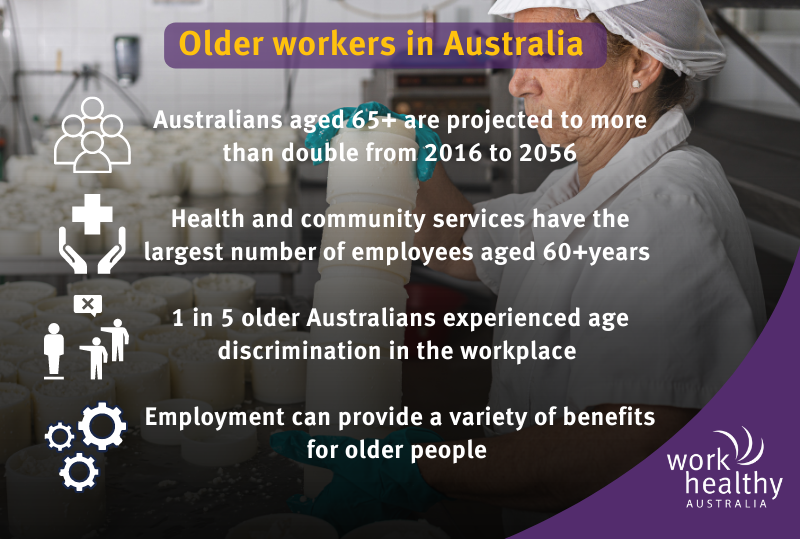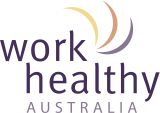
Australians are increasingly working to older ages. In April 2021, 15% of the workforce was aged 65 and over, compared to just 8% in 2006.
As workers age, a number of health and safety factors need to be considered and managed in the workplace. Degenerative change, for example, is the main barrier to injury recovery in workers aged 50+ we treated over the past three years. In this article, we delve into the specific health and safety challenges of this demographic and what employers can do to to support their workers.
Older Australians play an important role in the workforce. They can contribute extensive knowledge, skills and experience. With increasing workforce participation of older workers and delayed retirement age, employers need to ensure they are supporting the needs of this demographic.
Health and safety considerations
With an increase in age, there are a number of physiological and psychological changes that need to be taken into consideration. Some of these include:
- Decreased mobility
- Decreased strength
- Increased risk of falling
- Degenerative changes
- Slower rehabilitation from injury
- Higher work-related stress
According to Safe Work Australia, older workers are not any more likely to experience an injury or illness at work, but when they do, it is more likely to be serious or result in a fatality. When older workers are injured, recovery times are often longer. As a person ages, their ability to recover and return to their full duties may be complicated by other health concerns. These barriers do not mean an individual cannot recover from an injury; it may just take longer.
In fact, factors such as degenerative change, pre-existing injuries, longer recovery time, poor overall health and high BMI represented 35% of the barriers to recovery in workers 50 years and older we treated in the past three years.

How to help your ageing workforce work safely
There are a number of ways in which you can help your ageing workforce:
- Provide early intervention onsite treatment to support workers for work-related and non-work related pains/niggles and injuries.
- Consult with older workers about their needs. This may include surveys or discussions between managers and staff.
- Place the right people in the right role, by using Pre-employment screening and Fit-for-task Assessments with your onsite health provider.
- Build a workplace culture that values diversity and does not discriminate against age or others factors. Facilitate multigenerational communication and collaboration at work.
- Provide workers with the necessary information, support and flexibility to continue working. This may include more daytime shifts rather than night or shifts shorter in duration.
- Offer blended roles where high intensity manual tasks can include lighter duties.
- Offer team stretches, where the team leader or onsite healthcare provider takes the whole team through a series of stretches, particularly those areas that are at risk from injury during repetitive tasks or heavy manual labour.
- Provide task-specific manual handling training that is tailored to your workplace and helps workers identify hazardous tasks and manage risks.
- Explore work design principles. Allowing workers to have more control over the method and timing of their work has been shown to reduce levels of anxiety and depression and increase levels of job satisfaction.
Organisations that take the time to support the health and safety of older workers experience a range of positive results, including higher levels of job satisfaction, decreased absenteeism and turnover, and increased engagement amongst older workers. These benefits also extend across the broader workforce. (Work Safe QLD).
Age discrimination (and how to avoid it)
Age discrimination directly occurs when someone is treated less favourably because of their age, when someone from a different age group would be treated differently in the same situation. It can also indirectly occur when there is a rule or policy in a workplace which may have an unfair effect on a particular age group.
There can be many benefits to an ageing workforce including an increase in knowledge and experience in the field. To avoid age discrimination in your workplace, identify and address any policies that may contain discrimination towards a particular age group as well as aim to remove any bias from the hiring process to ensure it is fair and equitable.

Effectively treating injuries
Early intervention and prevention is the key to effectively treating injuries in an ageing workforce. By having an onsite healthcare provider, you can regularly check in with workers in these age brackets and provide early intervention injury management as well as tailored strengthening programs if needed.
An onsite provider can regularly assess the tasks being completed by these workers and can provide individual feedback and changes that can be made to reduce the risk of injury.
For further information or advice about how to manage an ageing workforce in your workplace, contact Work Healthy Australia.
Sign up to our monthly enewsletter
"*" indicates required fields
